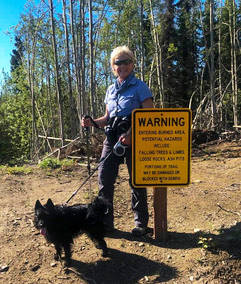Losing our hard-fought wins for public and dog safety will take us back to the ‘70s.
If you are like me, you enjoy walking your dog up Ski Hill Road, hiking the many beautiful trails, and camping on the Kenai National Wildlife Refuge. For the last 35 years, I’ve felt it was a safe place to be because of the safeguards built into the refuge trapping program. But I am old enough to remember before the refuge trapping regulations went into effect in the ’80s.
Every year somebody’s dog (or an eagle) would be caught in a snare or leg-hold trap. Many abuses occurred back then including: traps set on popular trails, traps left out after the end of the season, overharvest of lynx and beaver, traps left unchecked so eagles, moose, bear and other non-target species could not be released when they still had a chance of survival, and use of the ugly, toothed-leg hold trap. Those were bad days of trapper-recreationist conflicts.
In June 2020, the U.S. Fish and Wildlife Service, at the direction of Interior Secretary Bernhardt, proposed new rules for the Kenai refuge. This proposal has the potential to seriously harm many recreational users. One of these many changes would completely eliminate the refuge trapping management program.
Instead of the Fish and Wildlife Service managing this use, the State Fish & Game would set the seasons but do little to regulate trapping or resolve conflicts between users. These proposed changes to the management program would affect many areas of the refuge, including the popular Ski Hill Road, the campgrounds along the Swanson River Road, visitor centers, and public use cabins. There would be no changes to the Skilak Recreation Area, which operates under special rules.
The proposed changes would:
Eliminate the 1-mile buffer between traplines and trailheads, campgrounds, public use cabins, refuge roads and visitor centers;
Eliminate the requirement to periodically check traps;
Eliminate refuge trapping permits;
Eliminate the required, one-time trapper orientation class;
Eliminate the need to mark traps so the trapper can be identified;
Eliminate the ban on toothed leg-hold traps;
Eliminate special precautions to prevent accidental trapping of eagles and other non-target species.
The state regulations do not provide any of the important safeguards in the refuge permit requirements, which were developed in consultation with the state. They were developed by the refuge over a considerable period of time and included much public input from all user groups, trappers and recreationists. These regulations have worked well for our community, keeping our pets and untargeted wildlife safe.
The only press release on this proposal was released on Friday before Memorial Day. The comment period opened June 11, (opening day of red salmon season). Without any public meetings, the comment period closes on August 10. Please send a message to Washington to make our voices heard. Tell the Fish and Wildlife Service to keep refuge roads, trails and campgrounds safe for all users by not adopting the proposed regulations.
You can find the link to comment online as well as background materials on the Friends website at: alaskarefugefriends.org. Comments will be accepted until 7:59 p.m. on Aug. 10, next Monday.
Becky Hutchinson is a board member of Friends of Alaska National Wildlife Refuges and a 36-year resident of Soldotna, a 42-year resident of the Kenai Peninsula, and a 58-year outdoor lover of Alaska.

